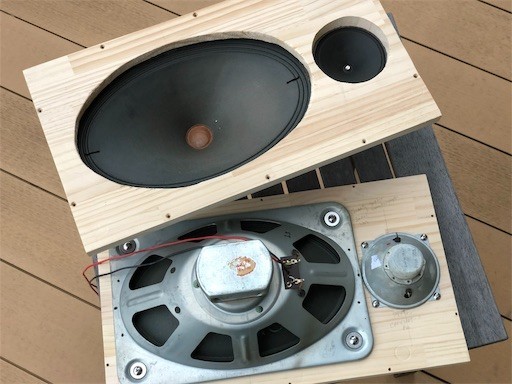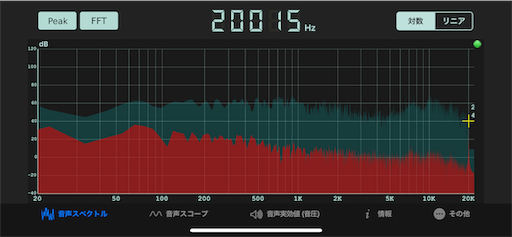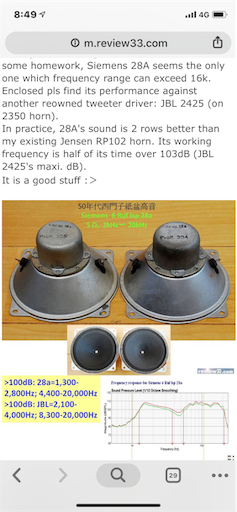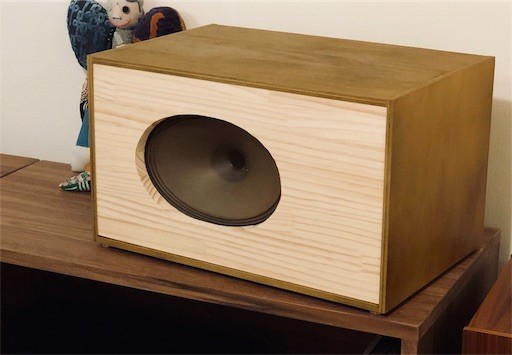Siemens 6Ruf lsp 28a


Frequency response of my two way speakers, Graetz typ.5400(Isophon P2132 equiv.) and Siemens 6 Ruf lsp 28a, 6dB/oct network at 2.5kHz.
Ignore red plot, see background gray plot. Gray represents peak level sweep from 20Hz to 20kHz.
Connected the sine wave generator to the amplifier, sweeped from 20Hz to 20kHz and measured by iPhone Sonic Tools APP.
Definitely, I need to do something on the dimple @ 3kHz to 5kHz.


This is the response of full range Telefunken 18cm x 26cm, in the same open back box. No dimple, so it is not caused by the room acoustic nor the box.

Replaced the tweeter of the two way by Telefunken 10cm unit, part number unknown, very similar to the Siemens. Similar dimple as Siemens 28a, while Siemens has better high response.

Characteristic of bare Telefunken tweeter. Dimple exist.

Siemens 28a found on the web. Similar.
Also found some articles saying crossover for 28a should be 5kHz. Sounds reasonable.
Sound-wise, Telefunken full range is better, except two way’s deeper bass.
I will try 5kHz crossover on the two ways ;-)
DAS-703ES Passive LPF works

Meauring my passive LPF with 10mH inductor, to check if it matches to the LTspice simulation.

I turned off the DAC, input sine wave (from 20Hz to 1MHz) to just after IV stage, check the wave form both at the input point and LPF output point, just before the Line level output buffer FET.
The sine wave level is 2Vp-p, slightly below 16bit 0dB (full scale) level here. 40MHz analog oscilloscope with 10:1 probe. Higher level signal is at LPF input, lower at LPF output.

20Hz

100Hz

1kHz

10kHz

20kHz

40kHz

60kHz

100kHz

200kHz

400kHz

1MHz
It seems working as similar as the spice simulation, including the phase shift.


This is the wave form of 20kHz 0dB reference signal of the Audio Test CD. With DAC power on, and the coaxial SPDIF from CDP-553ESD.
You can see 2x oversampling digital filter of DAS-703ES is actually working as expected ;-)
SONY DAS-703ES Op Amp Bypassing

For my ear, this Sony’s old school TOTL DAC sounds strange, despite its non-compromise construction or parts selection.
It sounds, for me, not being alive, masked, veiled. Older CDP-101 sounds much better for me.
I experienced similar sound with later CDP-777ESA, and tried to do something on the 777. What I found was that NE/JRC5532s used in LPF stage of 777ESA were the main cause, while 101 uses JRC4560 for LPF.
5532 is a good audio op amp, but only when there is just one 5532 in the circuit, IMHO.
Now inside of DAS-703ES, we can find total six 5532s, work as generalized impedance converter to configure 6th order LPF.

In my previous Japanese post, I tried to reveil its sound by op amp rolling, and my choice was;
IV ... AD797
LPF ... AD827
Output ... AD797
To put single channel op amp to output stage, I needed to make adapter. Different connection for L and R.

For me, AD8065 was the best for output stage here, sound-wise. But after tried 8065, I noticed this chip has clear compatibility issue with 28.4V supply rail of 703ES.
So, I viewed schematics to find out what I can do.
LPF output goes into common drain FET, M5240 op amp drives push pull FET buffer. All these 3 components are in same feedback loop.
What came to my mind was ‘can I simply remove op amp?’
It has a common drain FET input stage, and should be no problem in receiving LPF’s higher impedance signal and in driving push pull FET. Since the load of common drain FET is a constant current, T.H.D. is much less than simple register load. But still we may have 0.2% or something, much worse than Sony’s number in brochure, 0.004%. But, who cares? IMHO, T.H.D. has almost no relation to sound quality, unless it is not much higher than 2~3%.
Ok, let’s try.

Remove M5240.
L-ch: short #1 and #7.
R-ch: short #16 and #10.

Works pretty fine.
Better transparent sound, lower power consumption and being free from headache of op amp selection, at the cost of worse T.H.D.
Beautiful modd ;-)
This success encouraged me to work on other op amps, especially 2ch x 3 in LPF for each L and R.
AD827s already achieved good airy sound, but very hot - power consuming, and make power regulator TR really hot.

By simply removing all of LPF op amps, we still can hear sound. But highs are reduced just as my Spice simulation above.

On Spice, I found my solution.
Bypassing all 5532s and C and R connected to op amps, and connecting 2.2k just before LPF and 2.2k just after LPF by 10mH inductor.

Above fig shows my two mods, bypassing output and LPF op amps.

Points of registers leads we need to pull out from PCB.

Done. Using TDK 10mH coil.
Result? Perfect.
Sounds are now totally unveiled, and good for healthy power supply operation also.
You can also try simply short two 2.2k registers, without using 10mH inductor. In such case, frequency response will be as below.

For my ear, this setup sounds bit strange, and I recommend to use 10mH.
Finally, I have only one op amp left in the circuit, IV conversion.
After all above mods, I found OPA627 clearly outperforms other amps for IV stage.
AD797 ... Good detailed and dynamic sound with unique sense of quietness. But sometimes, I can notice not natural expression.
(Later, I found AD797 was slightly oscillating...)
MUSES03 ... Detailed and airy, but no emotion.
AD844 or AD846 ... Start oscillating.
Bottom line.
To unveil the sound of 503ES, most important modd is bypassing tons of 5532 LPF by 10mH. Or, you can replace all of 5532s by AD827s.
Stock LF356 at IV and M5240 at output stage are not really bad. Works on these are optional, still recommended though.
My next try can be replacing final op amp by discrere components. Before that, I need to study more about base-common BJT, current mirror and so on.
Graetz Siemens Telefunken

My best loud speaker so far, Telefunken 18x26 oval unit, circa mid 1950, in open back cabinet. Baffle size is 45cm x 25cm.


My initial trial was using Graetz 21x32 unit (Isophon P2132 equiv.) as full range, and I found, though it claims response up to 8kHz, I need to cut higher than 2.5kHz.

Firstly, installed few dollars Foster tweeter, then switched to Siemens 6 Ruf lap 28a, and finally Telefunken 10cm, mostly due to appearance matching to Graetz.
Both 6db/oct, phase inverted.

Inside stuffing.
Closed cell foam on the walls expecting to absorb low frequency reflection, and center wool felt for higher frequency resonance.
Even for open back speaker, these treatment gives noticeable difference.
These two way speakers were really nice, at least until I tried smaller 1826 Telefunken.
Anyway, very low frequency, such as we can feel by our body instead of hearing, cannot be expected from these open backs.
Free liveness is the priority of these system. And on this, full range Telefunken is definitely better than Graetz/Telefunken two way.
SONY DAS-703ES Op Amp Rolling

最近のおもちゃ、ソニーDAS-703ES。1985年製、定価25万円。

アルミの棒材が使われた筐体構造は一点ものの測定器のよう。
音質の評価はあまり高くはなく、実際CDP-101と聴き比べてもくぐもった元気のない音に聞こえる。

opアンプはチャンネルあたり5個。
PCM53JP-Iの出力を受けるIVに1chが1つ、LF356。
LPFを構成するsimulated inductorに2chが3つ、JRC5532DD。
出力のプッシュプルFETのドライバーに2chの片チャン使いが1つ、M5240。
N5240はスルーレート40V/usという高性能品で、変な16ピンの2chパッケージしかないやつ。アナログボードのデュアルモノ構成を維持するために片チャン使いにしたのだと思われる。うーむ。
くぐもった変な音は、より後のCDP-777ESAあたりでも経験していて、主たる原因は束で使われてる5532。CDP-101のアクティブLPFはJRC4560なので、まだまともに鳴っているのだろう。5532は、回路に1個だけ使う分にはとてもいいんだけど...。


都合10個のopアンプを全部ソケット化。

変なパッケージのM5240のところは、1chのopアンプに変換するアダプタを作ってみた。LとRとで逆側を使ってるのがめんどくさい。
お正月をはさんでいろいろ焦がしたりしながら試した結果のラインナップはこんなん。
IV ... AD797
LPF ... AD827
Output ... AD8065
ちなみに焦がしたのは発振対策のつもりでLをかませてLPFに挿したLT1364。この部分、音質的にはとにかく速い石が、安定性的にはcapacitive loadに強い石が要るらしい。速さで投入したTHS4601も発振してしまって残念。
ちなみに5532を全部4560にすると、ボクシーな低音の、それでもちゃんと聴けるCDP-101風の音になる。
さあこれで幸せ、と思っていたところ、8065に絶対最大定格26.4Vをこえる29Vをかけてしまっていたことに気がついた orz
OutputステージもAD797にしてしまうとちょっと狂気が勝ちすぎる。OPA627だとぼくの趣味にはtoo much forgivingで、too much laid back。だいたい電源とかしっかりしていて、ほっといてもしっかり低音出るんだこの機械。やっぱりAD8065がいいバランス。
こんなのアナログ電源のツェナーのあたりの分圧抵抗変えれば楽勝じゃん!と調べてみたら、それではPCM53の動作電圧に足りない。出力opアンプのところだけ電源ラインにダイオードでもかまそうか、などとパターン図や回路図を眺める。

5240だってFET入力なのにその前でソースフォロワで受けて、5240は非反転でゲインなし。プッシュプルFETの先、写ってないけどカップリングコンデンサがある。他にはポップノイズ対策とかいろいろ。
で、これ、実はopアンプいらないんじゃね、と気がついた。いまここ。opアンプ外して5240の非反転入力1番と出力7番とを短絡させればいい。
ソースフォロワ起因のDCオフセットが出る可能性があるけれどどうせコンデンサがある。
定電流負荷とはいえソースフォロワの非線形性で高調波歪率が0.2%くらいにはなるのかな。メーカー品としては、0.004%とかいう値をカタログに載せる必要があるのだろうけどぼく関係ない。メイクワンシィ。
どうしても気になるんだったら2段ともエミフォロにすれば少しはよくなるし。
というわけで、おうちに帰ったらopアンプのところ短絡させてみましょう。
ヘッドホンバランス駆動リケーブルシステム
下で、ATH-A2000Xのバランス駆動対応リケーブルの話を書いたけど、シングルエンド出力であるMHPA-FET改の出力端子はヒロセの4pinコネクタに付け替えてあって、ATH-ESW10JPNなどの端子もステレオミニからヒロセに付け替えてあって、とそういう経緯を書いていなかったことに気がついた。11月以降、やたらと出張が多くてわけわからなくなってしまってたんだな。むーん。

前にも紹介したHR10A-7R-4S。これがステレオミニジャックの替わりにアンプにつく。対応するヘッドホン側はHR10A-7P-4P。

接続端子を付け替えたMHPA-FET改とATH-ESW10JPN。ケーブルはAPureSoundのER-4P用を流用。
ヘッドホンをバランス駆動するメリットはと言うと、
- 同じ電源電圧でパワー4倍。高インピーダンスのヘッドホンでも電池でOK
- アンプの規模が倍になり、対応して電源が強化されることによる音質向上
- コールド側もドライブすることによるダンピングファクターの向上
- 必然的にCOLD側がLRで分かれるので不必要なLRのクロストークが減る
- たいてい、端子がステレオ(ミニ)プラグよりもがっしりしたものになるだろうから、接続が安定する
といったところだろうか。
オリジナルのMHPA-FETに対して、OPアンプ+FETプッシュプルを1回路追加して3chアンプとしてあるMHPA-FETでは、3番目は半分対応済み。今回の出力コネクタの付け替え時に、LRの出力GNDを、GNDchのOPアンプの帰還ポイントから分けて配線したので、4番目もかなりOK。
MHPA-FET改の電源はLiIONの3セルで、ATH-A2000Xならまず問題ないのだけど、HD650ではたまに電圧が足りない原因の歪みが発生している気がする。ソプラノとか。これは1番目の問題。OPアンプ+FETプッシュプルをもう1回路追加してバランス駆動アンプとすれば解決だけど、その場合、抵抗分圧で作っているGNDにはアンプを入れた方がいいのだろうか。そうだとすると2回路追加が必要で、まあ今の筺体には入りそうもない。
A2000X/HD650用のφ0.4mm銅単線ケーブルができたら、あとはバランスアンプを作るだけ。来春くらいにはできるといいな。


